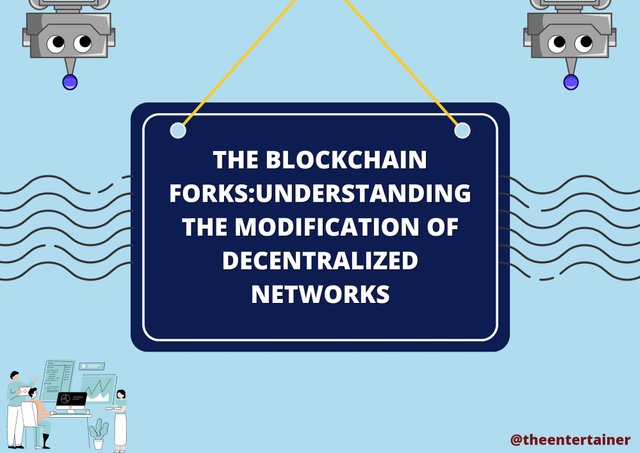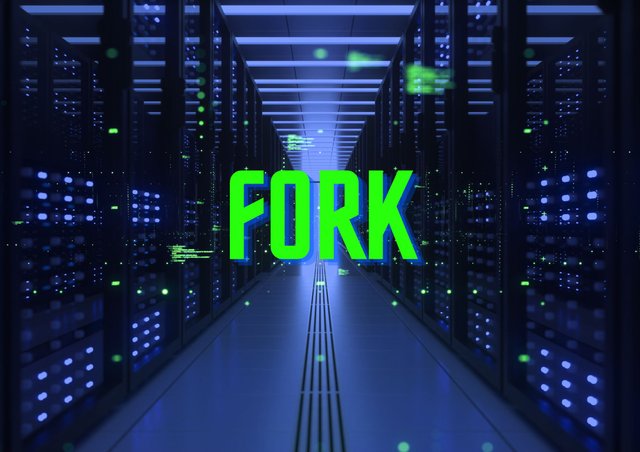Hi, all my friends did you ever listened to the term fork, I hope so because we are all working in a blockchain platform and how can't we know the term, but many don't know it in detail, so here is a guide which will help you to know the details about blockchain forks there classification and work.

Made With Canva

A fork is a divergence or split in a project, system, or codebase that results in two or more different development paths. It can happen in a variety of settings, such as software development, open-source initiatives, and blockchain technology. A fork occurs in software development when a developer or group of developers creates a distinct copy of an existing project in order to pursue autonomous development. This can happen owing to conflicts, competing goals, or a desire to try out new features or directions.

Made With Canva
A fork in the context of open-source projects occurs when a new project is developed from an existing one, frequently owing to community disagreements or differences in the project's direction. The new project has its own codebase and can be developed separately. A fork in blockchain technology refers to a substantial shift or divergence in a blockchain network's underlying protocol.

Fork in the blockchain resulted in creation of two separate chains, each following a different set of rules. There are generally two types of blockchain forks: hard forks and soft forks.
Hard fork:- A hard fork occurs when the protocol of a blockchain experiences a significant change that is not backward-compatible. Nodes or participants that do not upgrade to the new ruleset will be unable to validate or process blocks on the new chain. As a result, the chain becomes divided into two distinct chains, each with its own transaction history and network.
Example:- The launch of Bitcoin Cash (BCH) in August 2017 is one significant example of a hard fork in Bitcoin's history. At the time, a group of developers and community members advocated changing the Bitcoin protocol to extend the block size limit from 1MB to 8MB. This change was made to alleviate scalability difficulties and to enable faster and cheaper transactions. However, because the proposed change was not generally approved by the Bitcoin community, a disagreement ensued, resulting in a hard fork of the blockchain. As a result, a new blockchain dubbed Bitcoin Cash was created, with it's own transaction and features.

From Pixabay
Soft Fork:- A soft fork, on the other hand, is a backward-compatible change to the blockchain protocol. It adds new rules or features that are still recognised by the network's older nodes. This implies that members who haven't updated can still validate blocks on the new chain, preserving a single unified network. However, upgraded nodes can enforce the new rules and enjoy greater functionality.
Example:- The introduction of the Byzantium update in October 2017 is an example of a soft fork in Ethereum's history. Byzantium was a planned upgrade to the Ethereum protocol that added various new features, upgrades, and bug fixes. These improvements included improvements to privacy, efficiency, and security. The Ethereum network received additional restrictions as part of the Byzantium upgrade. These new restrictions, however, were built in such a way that older nodes could still recognise and validate blocks that adhered to the upgraded protocol. The upgraded nodes enforce the new rules, while the older nodes continue to operate under the old rules, accepting new blocks. So, this only include changes within it's own blockchain rather than making a separate one.

In a nutshell, Forks are generally are changes to a blockchain it further classified as Soft Fork and Hard Fork. While Soft forks typically introduce incremental changes, security patches, or minor updates to the blockchain. A Hard forks often occur due to disagreements, major protocol upgrades, or the creation of new features or functionalities. And creates separate blockchain with it's own rules, transactions or also different currency.

https://twitter.com/SibanandaMaha14/status/1666511724378468352?t=-Y8MKBw6hlnfuJebCVQbvw&s=19
Downvoting a post can decrease pending rewards and make it less visible. Common reasons:
Submit
Good explanation about forks in crypto space.
Yes, in crypto we have two types of forks: soft forks and hard forks.
From a soft fork, we don't get that much effect on users and the project. They do upgaradation only.
But in a hard fork,we get a new token into the market. Users also need to follow some rules.
You explain them very well. Thanks for sharing. Take care of you, my friend.
Downvoting a post can decrease pending rewards and make it less visible. Common reasons:
Submit